Understanding the Value of Black Diamonds in Today's Market
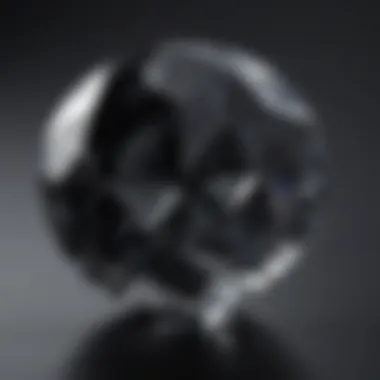
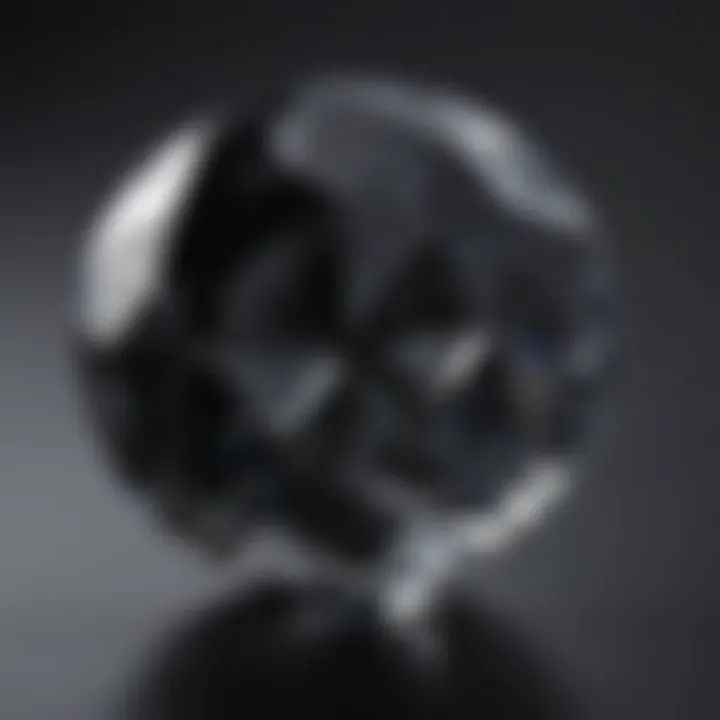
Intro
Black diamonds, often regarded as the dark horse of the gemstone world, possess an allure that sets them apart from their clearer counterparts. While traditional diamonds shimmer with brightness, black diamonds exude a kind of intrigue and depth that sparks curiosity among gemstone enthusiasts and collectors alike. This article aims to explore the intrinsic value of these unique gems by examining their characteristics, properties, and significant market presence.
Gemstone Overview
Definition and Characteristics
A black diamond, also known as a carbonado, is a type of diamond that is not entirely transparent, showcasing a deep, opaque black hue. This color arises from a unique internal structure composed mainly of inclusions like graphite, which grants these stones their striking appearance. Unlike traditional diamonds, whose worth is often appraised based on clarity, cut, and carat, black diamonds are judged through a different lens. Their worth often hinges on their mystique, rarity, and the trends influencing the market.
Classification of Gemstones
Gemstones fall into various categories based on their origin and properties. Black diamonds can be classified not just as distinct diamonds but also as a part of the broader group of gemstones categorized by color and appearance. Here’s a quick look at how gemstones can be classified:
- Organic Gemstones: Formed from once-living organisms, e.g., pearls, amber.
- Inorganic Gemstones: Born from non-living processes, e.g., diamonds, sapphires.
- Natural Gemstones: Mined directly from the earth.
- Synthetic Gemstones: Created in laboratories, yet can replicate natural forms.
Understanding these classifications is valuable as it opens discussions around the market perception of black diamonds, revealing their status within the gemstone hierarchy.
Properties of Gemstones
Physical Properties
The physical properties of black diamonds differ from traditional diamonds in several aspects. For starters, while regular diamonds often boast a sparkling facet, black diamonds exhibit a subtle sheen that appeals to a more niche audience. Additionally, black diamonds are more porous than traditional stones, which may impact their durability and care in jewelry settings.
Chemical Properties
Chemically, black diamonds are composed mainly of carbon, similar to other diamonds. However, their unique crystalline structure, indicative of the myriad of inclusions, influences their reactions under certain conditions, giving them a different aesthetic and, possibly, mechanical properties compared to colorless diamonds. This divergence not only influences their valuation but also their desirability in various jewelry designs, as they offer a fresh alternative to classic styles.
"Black diamonds present a new frontier in gemstone investment, representing both beauty and rarity that many gemstone lovers seek."
Summary Points
- Black diamonds represent a unique segment within the diamond industry.
- Their characteristics and classifications distinguish them from conventional diamonds.
- Understanding both physical and chemical properties is essential in gauging their worth and market demand.
As we delve deeper into the cultural significance and market trends surrounding black diamonds, we will uncover why these gems continue to captivate collectors and enthusiasts around the globe.
Prologue to Black Diamonds
Understanding black diamonds requires more than just their aesthetic appeal. These unique gemstones represent a fascinating intersection of natural beauty, geological processes, and cultural relevance. The uniqueness of black diamonds lies not only in their appearance but also in their story, encapsulating a rare blend of formation methods and market dynamics that challenge conventional notions of worth in gemstones. This article sets out to unravel these complexities, providing readers a nuanced understanding of the elements that contribute to the value of black diamonds.
Defining Black Diamonds
Black diamonds, often referred to as carbonado, stand out among other diamond types for their distinctive dark color and opaque structure. Unlike traditional diamonds, which are typically clear and exhibit brilliance, black diamonds present a rich, deep hue that is often associated with sophistication and elegance. Some might argue that their rarity adds to their allure; however, it’s essential to look deeper than mere surface impressions.
The defining characteristics of black diamonds include their high inclusions and irregular crystal structures, which can make them appear less desirable to traditional gemstone collectors. Yet, this very irregularity contributes to their charm. Each black diamond tells a different story, making them sought after by collectors who appreciate their uniqueness.
Furthermore, the symbolism behind these stones can’t be overlooked. In various cultures, black is often linked to power, protection, and resilience, adding another layer of significance to these gems.
The Formation Process
The formation process of black diamonds is considerably different from that of traditional diamonds. They are believed to originate from supernova explosions or meteorite impacts, which means that their existence ties them closely to cosmic events on a grand scale. This extraterrestrial origin makes them particularly intriguing, fueling interest beyond the realm of mere aesthetics.
- Natural Formation: Black diamonds form under conditions of extreme pressure and temperature, deep within the Earth’s mantle. Over millions of years, they evolve in ways that are still not entirely understood by experts.
- Synthetic Options: In recent years, advancements in technology have allowed for the creation of synthetic black diamonds. These lab-created stones share aesthetic properties with natural ones but lack the geological history that many collectors seek.
Rarity and Value
Rarity and value are two pillars that influence the perception of black diamonds in the gemstone market. While some may see these gems as simply another type of diamond, understanding their true rarity adds layers to their worth. This section unveils the complexities surrounding black diamonds and highlights why rarity isn’t just a number on a certificate—it connects deeply with market trends, aesthetic preferences, and cultural significance.
Understanding Rarity
When diving into the topic of rarity, it’s important to grasp what makes black diamonds unique in comparison to their more popular clear counterparts. Black diamonds, also known as carbonados, are not formed in the same manner as traditional diamonds. Their formation occurs under extreme conditions and typically involves a mix of other minerals, which makes them less abundant in nature. Unlike colorless diamonds that are often mined from well-known sources, the origins of black diamonds remain somewhat mysterious, often traced back to volcanic eruptions.
A key element of rarity is not just how many exist, but also how desirable they are. Black diamonds, with their opaque surface and unique allure, have carved a niche in the jewelry market, often sought after for statement pieces. Their distinctive appearance means they cater to a clientele that values uniqueness and individuality, both traits increasingly valued in contemporary culture.
Comparative Rarity
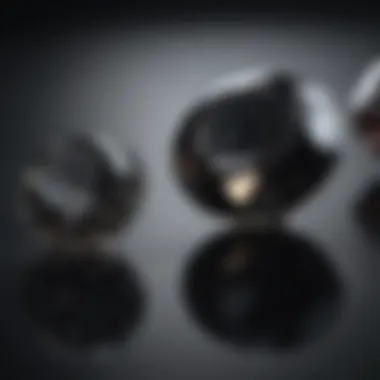
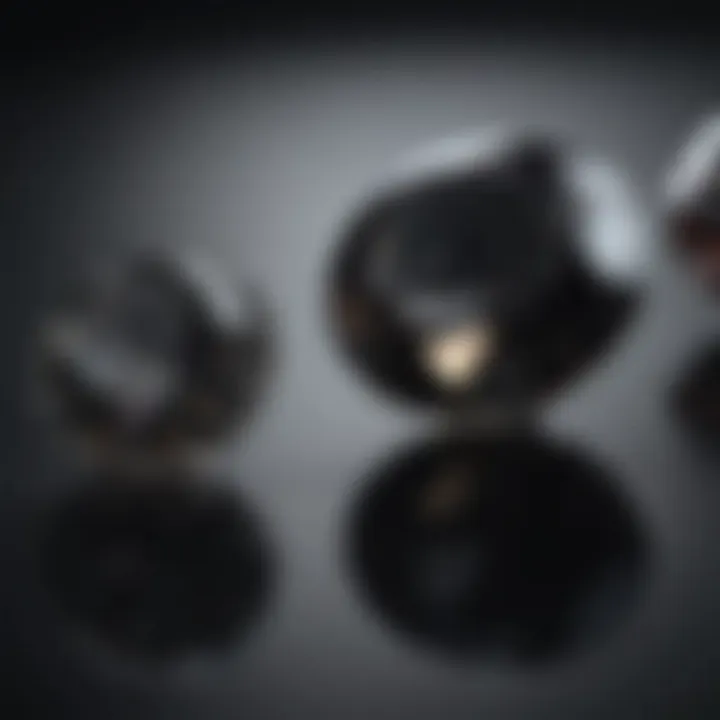
Black Diamonds vs. Colorless Diamonds
In any discussion of rarity, the comparison between black diamonds and colorless diamonds is inevitable. Colorless diamonds dominate the market, often touted as the epitome of beauty and clarity. However, black diamonds hold their own, featuring a stark contrast in appearance that appeals to many buyers. While colorless diamonds are assessed via the 4Cs—cut, clarity, color, carat weight—black diamonds don’t fit neatly into this mold. Their beauty lies not in brilliance and reflections but in a more rugged, raw aesthetic. This difference is crucial in evaluating their value.
Moreover, the perception of value can drastically shift based on trends. In recent years, more individuals desire gemstones that tell a story, a quality that resonates deeply with black diamonds. In terms of rarity, black diamonds offer a compelling case; they are not merely less common—they represent a rebellion against the traditional ideals of diamond beauty, making them appealing for those looking for something out of the ordinary.
Comparative Analysis with Fancy Colored Diamonds
Fancy colored diamonds have become increasingly popular, and their rarity often overshadows that of black diamonds. However, it's critical to analyze this dynamic carefully. While colored diamonds can fetch staggering prices based on their hue, saturation, and tone, black diamonds appeal to a different set of aesthetic tastes. The bold, dark brilliance of a black diamond can often evoke a sense of mystery and power, attributes that many collectors find alluring.
Here, the key distinction lies in their market presence. Fancy colored diamonds bring with them a hue that can be classified and appraised along specific guidelines, while black diamonds disrupt conventions, leading to an ambiguous yet intriguing valuation process. Their unique quality means they can both serve as a statement piece and an investment, especially as consumer preferences evolve towards more individualistic and emotionally resonant choices.
- Black Diamonds
- Colored Diamonds
- Rugged, raw beauty
- Less conventional, breaking traditional beauty standards
- Growing respect in market due to individuality
- Highly valued for specific hues
- Strict guidelines for classification
- Shine in conventional luxury spaces
Ultimately, while each type of diamond holds its own appeal and challenges in the market, black diamonds carve out a significant place based on how unique and different they represent in comparison. As we unfold the layers of black diamonds, their rarity and value emerge as two intertwined threads in the intricate fabric of the gemstone market.
Market Demand and Trends
In today’s competitive jewelry market, understanding the market demand and trends surrounding black diamonds is critical for anyone looking to appreciate or invest in these unique gemstones. The dynamics of demand stem from an amalgamation of fashion trends, cultural influences, as well as shifting consumer preferences. For gemstone enthusiasts, comprehending these facets is vital as it highlights not only the allure of black diamonds but also their investment potential.
Current Market Conditions
The current market conditions for black diamonds reveal a growing interest among buyers who seek alternatives to traditional white diamonds. The shift can be attributed to several factors:
- Aesthetic Appeal: Black diamonds are increasingly being perceived as bold and sophisticated, making them a popular choice for contemporary jewelry designs. Their dark tone sets them apart, creating a striking contrast with other gemstones.
- Increased Visibility: The rise of social media platforms has propelled the visibility of black diamonds. Influencers and celebrities flaunt them in various forms, driving consumer interest.
- Supply Dynamics: While they are not as rare as some colored diamonds, black diamonds are still not as abundantly available as colorless diamonds. This limited supply helps sustain their market value.
As buyers become more discerning, they often look for pieces that communicate a unique style or story, leading to an uptick in the demand for these captivating gems.
Consumer Preferences
Understanding consumer preferences for black diamonds involves looking at both emotional and practical aspects:
- Personal Expression: Many consumers opt for black diamonds for their individuality. The allure of wearing jewelry that differs from the norm resonates deeply with a generation drawn to personal expression in style.
- Gift-Giving Trends: Black diamonds have become popular as gifts, particularly for engagements and anniversaries, embodying a sense of personal significance.
- Cultural Shifts: The evolving views on what gemstones symbolize mark a notable trend. Traditional ideas about diamonds being only colorless have begun to shift, paving the way for diverse options that include ethically sourced and unique stones, resonating particularly with younger consumers.
Historical Context
When tracing back the history of black diamonds, one finds that their value and perception have changed dramatically over time:
- Cultural Associations: Historically, black diamonds were often regarded with skepticism, considered less desirable compared to their colorless counterparts. Yet, in some cultures, they were associated with strength and protection.
- Gemological Advancements: As gemology advanced, a greater understanding of the properties of black diamonds emerged. This, in turn, enhanced their desirability; people began to appreciate their unique imperfections and earthy appeal.
- Collectible Value: Not so long ago, they were relegated to an afterthought in the diamond market. Now, seasoned collectors have begun recognizing their potential value, understanding that rarity isn’t the sole determinant of worth.
Today, black diamonds occupy a niche that blends tradition with modern aesthetics. As the market continues to evolve, the ongoing exploration of their value will undoubtedly reveal deeper layers of significance that these gems hold within the world of jewelry.
Cultural Significance
When delving into the value of black diamonds, one cannot overlook their cultural significance. This aspect goes beyond mere aesthetics or market trends. Black diamonds carry an air of mystery and a deeper connection to various societies around the globe. They serve as symbols—a reflection of the beliefs, traditions, and stories that give them their weight in human culture.
Symbolism in Different Cultures
Across the world, black diamonds are repurposed and reimagined through the lens of diverse cultures. In some societies, their bold, stark hue represents strength and resilience. For instance, in certain African cultures, black gemstones—including diamonds—are seen as protectors, believed to ward off evil spirits and misfortune. This protective symbolism may even elevate their status among collectors looking for meaningful pieces.
Conversely, in Western contexts, black diamonds often evoke thoughts of sophistication and rarity. The allure of darkness often speaks to those embracing the unconventional, making these gemstones favorites among fashion-forward individuals or those drawn to gothic aesthetics. Thus, it is common to see black diamonds adorned in modern jewelry as a statement of individuality.
- Symbol of Power: In some ancient civilizations, black stones were utilized by leaders and warriors as symbols of authority.
- Mysticism and Spirituality: Many cultures ascribe spiritual meanings to black gemstones, linking them to protection, grounding, and connection with the earth.
- Counter-Cultural Flair: In contemporary settings, they often represent rebellion against norms, making them popular amongst alternative lifestyles.
Though the interpretations vary widely, what remains consistent is how black diamonds establish a strong connection between the wearer and the larger tapestry of cultural narratives.
Legends and Myths
The mystique surrounding black diamonds is not just a modern phenomenon; it has deep roots in lore and legend. Mythical accounts of black diamonds can be found across various cultures, enhancing their value through stories that create a sense of intrigue.
One notable example is the legend surrounding the Black Orlov diamond, a stone that allegedly cursed its owners with misfortune. This curse narrative adds layers of fascination to the diamond, as tales of bad luck intertwine with its historical status. According to folklore, the diamond was stolen from a Hindu temple in India, and its dark history only fuels interest in those willing to brave its reputed powers.
Additionally, some believe that the rarity of black diamonds has led them to be regarded as tokens of fortune. In particular, there are stories that link them to wealth and prosperity, leading some individuals to wear or present black diamonds as gifts intended to bring luck.


These myths intertwine with cultural perspectives, encapsulating the diamond’s essence as not just a piece of jewelry but a vessel of history—a way for individuals to connect with stories of the past while investing in their future.
"The value of a diamond is not just in its brilliance, but in the stories it carries through the ages."
Understanding these cultural narratives and legends, one can appreciate how they augment the perceived value of black diamonds, making them much more than mere items for adornment.
The Role of Treatments
When it comes to understanding black diamonds, the role of treatment should not be underestimated. Treatments can significantly shift perceptions and values in the diamond market, influencing both collectors and potential investors. They reflect a mix of gemology and artistry, and can either enhance the natural allure of these gems or potentially detract from their desirability, depending on the context.
Common Enhancement Techniques
While black diamonds are inherently unique due to their color and characteristics, many of them undergo various enhancement techniques to improve their appearance.
- High-pressure high-temperature (HPHT): This process mimics the natural conditions under which diamonds form. It can clarify a diamond by removing impurities, thus impacting its overall appearance.
- Laser drilling: This method is used to remove inclusions and flaws from black diamonds, bringing out a clearer, more pristine facet of the stone.
- Coating: Some stones get a thin layer of material added to enhance color or shine. This can change how the stone looks but might not be permanent.
- Irradiation: Exposure to radiation is a widely used method to enhance the color intensity of black diamonds. This treatment can deepen the black hue and add richness.
These techniques contribute to a range of black diamonds with different visual properties and potential uses in jewelry, making the assessment of each diamond’s treatment crucial for consumers.
Impact on Value
The impact of treatments on the valuation of black diamonds can be a double-edged sword. On one side, enhancements can increase the aesthetic appeal and marketability of a diamond, potentially raising its price. On the other hand, treatments can also lower a diamond's value if they are perceived as masking underlying issues or if they are not disclosed to buyers.
Purchasers must always consider the degree of enhancement a diamond has undergone:
- Transparency: Buyers often prefer, and sometimes demand, full disclosure regarding any treatments. A diamond labeled as untreated can command a higher price because natural qualities are rarer.
- Market Demand: The popularity of treated versus untreated black diamonds can shift based on trends and consumer preferences. For instance, some collectors may specifically seek out untreated gems as a form of investment, focusing on the potential for long-term value appreciation.
- Long-term Effects: Some enhancements are permanent, while others can wear off or diminish over time. Understanding the longevity of a treatment can guide consumers in making an informed choice.
"In the world of gemstones, knowledge is as valuable as the stones themselves. Knowing a diamond’s treatment history can be the difference between a wise investment and a regrettable purchase."
Black Diamonds in Jewelry
Black diamonds have carved out a fascinating niche in the world of jewelry. Their unique physical properties and striking appearance set them apart from the more conventional colorless diamonds. The importance of black diamonds in jewelry extends beyond mere aesthetics; they represent innovation, style, and a departure from tradition.
One significant element concerning black diamonds in jewelry is their versatility. They can harmoniously blend into various styles, from modern and edgy designs to vintage aesthetics. Jewelers often experiment with black diamonds, incorporating them into engagement rings, pendants, and earrings. This adaptability enables wearers to express individuality through their jewelry choices.
Furthermore, the allure of black diamonds lies in their mystery. Unlike traditional diamonds that sparkle with clarity, black diamonds possess a unique luster, which evokes curiosity. Owning jewelry adorned with black diamonds often signifies sophistication and an appreciation for the unconventional.
Another point worth noting is the increasing demand for black diamonds. This growing interest among consumers has inspired jewelry designers to push their creative boundaries. As more individuals seek distinctive pieces, black diamonds have become a go-to choice for those aiming to stand out. Additionally, their relatively lower price point compared to colorless diamonds can make them an appealing option for budget-conscious buyers who still want a luxurious feel.
Design Trends
The design trends surrounding black diamonds have seen a considerable evolution in recent years. Originally perceived as a bold choice, designers have found ways to blend black diamonds with an array of materials and textures.
- Mixed Metals: Many jewelers are pairing black diamonds with yellow, rose, or white gold to create striking contrast.
- Geometric Cuts: New trends lean toward geometric shapes for black diamonds, enhancing their modern appeal.
- Cluster Designs: A stunning way to showcase black diamonds is through intricate cluster settings, where multiple stones come together to form a dramatic visual impact.
The rise of personalization also plays a huge role. More people want to create custom pieces that hold sentimental value, and black diamonds can be ideal for such endeavors. Their distinctive look allows for unique designs that can symbolize individual stories or relationships.
Notable Celebrity Use
When discussing black diamonds in jewelry, one cannot overlook their popularity among celebrities. Numerous stars have donned black diamond pieces on the red carpet, thus elevating the status of these gemstones in the eyes of the public.
For instance, celebrity couple Victoria and David Beckham made headlines with their stunning black diamond engagement ring, showcasing a departure from the classic white diamond. Their choice not only sparked conversation but also inspired fans worldwide to consider black diamonds as a viable and stylish option.
Similarly, Jessica Alba chose to wear a sophisticated black diamond ring during a major awards show, highlighting the versatility of this stone in high-fashion circles. Such high-profile endorsements have further solidified black diamonds' position in the luxury jewelry market, making them a favored choice for those keen to make a statement.
In the competitive jewelry landscape, black diamonds are more than just decorative stones. They embody individuality and creativity, serving as a canvas for modern designers and a bold choice for discerning collectors. As the trends evolve and consumer preferences change, black diamonds will continue to command attention, solidifying their worth in the ever-evolving world of gemstones.
Investment Considerations
Investing in black diamonds can be a tantalizing venture. It’s like walking a tightrope, balancing risks and rewards. At the heart of this section lies an understanding of just how valuable these gems can be, especially when compared to more familiar choices like colorless diamonds. The unique characteristics and market positioning of black diamonds reveal underlying benefits as well as significant considerations that potential investors should ponder.
Potential as an Investment
Black diamonds, known for their captivating dark allure, have carved out a niche for themselves in the investment landscape. Unlike their colorless counterparts, their value is not solely tied to clarity or color. Instead, their appeal lies in their rarity and the allure of the unconventional. Investors are drawn to seek diversity within their portfolios, and black diamonds provide an enticing alternative.
One of the more attractive aspects of considering black diamonds as an investment is their less volatile price trends compared to traditional gemstones. Specifically, while standard diamonds often fluctuate dramatically based on market trends, black diamonds tend to hold steadfast in value. With the growing interest in unique and rare gemstones, collectors may find black diamonds becoming increasingly sought after, which might play to an investor's advantage.

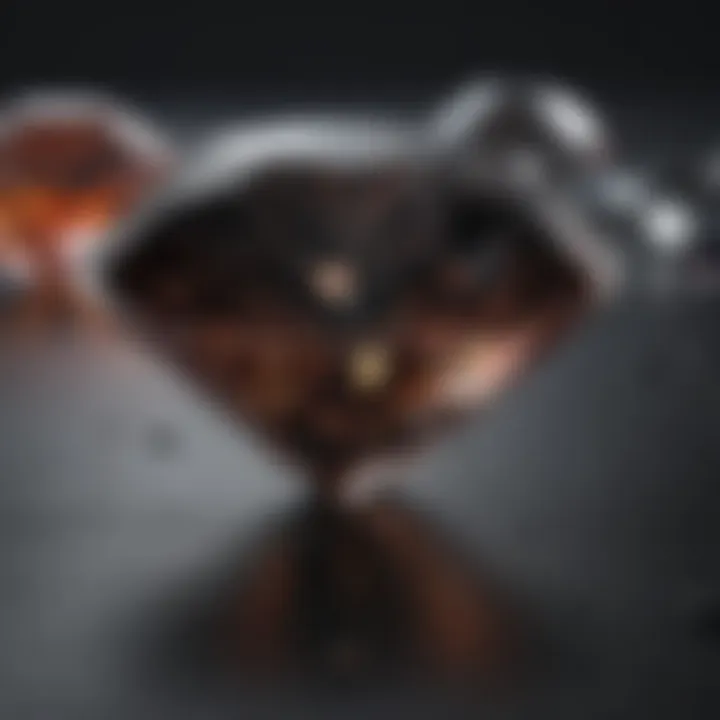
However, as with any investment, potential buyers should do their homework. Researching the mine of origin or the certification of the diamond can provide clues to authenticity and value. A well-documented stone can command a premium in the market, not merely due to its physical beauty but because of its provenance.
Risks and Rewards
When it comes to black diamonds, understanding the landscape involves navigating the dual nature of risks and rewards. On one hand, there is the risk of market misunderstanding. While the popularity of black diamonds is on the rise, they are not as widely recognized as investments in the broader public consciousness. Some collectors perceive them as less 'valuable' because they lack the conventional beauty associated with typical diamonds, which can lead to hesitation among potential buyers.
On the flip side, this perception can be a double-edged sword. As demand picks up, the potential appreciation in value can be significant. If black diamonds begin to gain acknowledgment as a serious contender in the gemstone market, investors could see the fruits of their early investment bloom remarkably.
"Investing in black diamonds is about being ahead of the curve, but it requires diligence and a keen eye for what’s next in the jewelry world."
In summary, the investment considerations surrounding black diamonds are intricate yet rewarding. Their growing acceptance and evolving status, coupled with their unique attributes, can pave the way for profitable investment opportunities.
Ethical Sourcing
When considering the value of black diamonds, ethical sourcing is not just a buzzword; it's a core principle that shapes consumer attitudes and market dynamics. As more buyers become aware of the hidden costs associated with diamond mining, the demand for ethically sourced stones has surged. Black diamonds, with their unique characteristics, are not exempt from this scrutiny. In fact, the very nature of their sourcing can significantly influence their perceived value in the marketplace.
Importance of Ethical Practices
Ethics in sourcing can fundamentally alter the landscape of the precious stones market. Here are a few pivotal points illustrating its significance:
- Consumer Awareness: Shoppers increasingly prefer gems that align with their personal values. Black diamonds can sometimes come from regions plagued with conflict or labor exploitation. Knowing this, many buyers actively seek ethical certifications like those from the Responsible Jewelry Council (RJC).
- Environmental Considerations: Sustainable practices are gaining traction. Ethical sourcing means less damage to ecosystems. Companies that prioritize these practices often utilize cleaner methods or opt for recycled stones, thereby reducing their ecological footprint.
- Community Impact: Responsible mining operations contribute positively to local economies, providing fair wages and fostering community development. This can elevate the brand image and desirability of the diamonds themselves, indirectly affecting their market price.
In essence, emphasizing ethical practices not only enhances the appeal of black diamonds but also paves the way for a more sustainable future in the jewelry industry.
Impact on Value Perception
The perception of value in black diamonds is increasingly shaped by their sourcing narratives. Buyers aren’t just purchasing a gemstone; they are investing in a story—a story defined not only by beauty but by ethics.
- Transparency Matters: Buyers often look for clear information about where and how their diamonds were sourced. If a black diamond is sourced from a mine known for unethical practices, its marketability will likely suffer.
- Natural vs. Enhanced Values: Ethical sourcing often correlates with natural stones as opposed to enhanced ones, which might be viewed with skepticism. Consumers might pay a premium for stones that can provide clear proof of their origin, including black diamonds.
- Market Trends: As more buyers advocate for social responsibility, the resale value of ethically sourced diamonds may stabilize more than those from questionable origins. An increase in demand for ethically sourced diamonds can push their prices upward, rewarding ethical purveyors.
"The dream of a beautiful black diamond can be tarnished by the grim realities of its sourcing. When buyers become informed, market forces reshape the narrative of value."
Challenges in Assessment
Subjective Nature of Value
The subjective valuation of black diamonds arises primarily from the individual preferences of buyers and collectors. What one person perceives as valuable might not resonate with another. A black diamond's worth is often tied to its aesthetics, the intricacies of its inclusions, and the personal stories they evoke. For instance, a buyer might fall in love with a particular stone due to its unique appearance, anchoring its value in emotional significance rather than just market trends. Collectors often express intense loyalty to certain gemstones, and this loyalty can skew the perceived value dramatically.
In addition to personal preference, the grading systems that predominantly focus on colorless diamonds might not apply as effectively to black diamonds. Factors such as the depth of color, reflective quality, and even the shape of the diamond can differ significantly from traditional metrics. As a result, assessing the value can be a highly individual process, often leading to significant discrepancies in market prices.
"The beauty of black diamonds often lies not in conventional metrics, but in their unique stories and appearances, each one carrying a personal touch that can be hard to quantify."
Market Fluctuations
The market for black diamonds is subject to fluctuations, much like a ship navigating through unpredictable waters. Various forces, from economic conditions to fashion trends, can greatly influence the demand for these gems. For example, during periods of economic prosperity, luxury items such as black diamonds might see a surge in demand as consumers are more willing to indulge in unique acquisitions. Conversely, in times of economic downturn, the desire for such extravagant purchases can wane, leading to decreased values and interest.
Additionally, the trends within the jewelry market play a pivotal role in shaping how black diamonds are perceived. Styles come and go, and what was once deemed trendy can quickly fall out of favor. For instance, the rise in popularity of alternative engagement rings has fueled interest in black diamonds, positioning them as a statement of individuality. However, if interest shifts again, the value can swing just as rapidly, showcasing the inherent risks involved.
Overall, these fluctuations make the assessment of black diamonds a complex endeavor, requiring astute knowledge of current market conditions, as well as an understanding of individual preferences and economic contexts.
Finale
Wrapping up our exploration of black diamonds, it’s clear that their value goes well beyond just the shimmer. They capture a certain mystique that both fascinates and perplexes collectors and jewelry aficionados alike. Understanding the layers of significance associated with these gems—ranging from historical contexts to market dynamics—offers insight not only into their pricing but also into their unique allure.
In summary, black diamonds possess a special place in the market that is shaped by their rarity, cultural significance, and the impact of ethical sourcing. Unlike their clear counterparts, they are captivating in their own right, often inviting deeper reflection on beauty and worth. Consumers and investors should consider the distinct traits that define these gemstones, such as unique color, lack of clarity, and the attitude they portray as an alternative choice in luxury.
Besides their aesthetic appeal, we explored how market trends can influence their value, revealing how consumer preferences shift in response to cultural attitudes. Evaluating the impact of treatments and the subjective nature of valuation plays a crucial role in understanding how these stones can fluctuate in desirability.
"Value is often seen through the lens of perception; in the case of black diamonds, perception is colored by complexities of rarity, treatment, and cultural narratives."
For anyone looking to invest or simply understand black diamonds better, recognizing the nuances underlying their value is paramount. It's like seeing the forest for the trees—once delved into, the depth of their existence becomes as rich as the stones themselves.
Recap of Key Points
- Rarity and Unique Formation: Black diamonds are formed under specific conditions, making them a rare find in the gem market.
- Market Dynamics: Trends change with consumer preferences; an understanding of what's in vogue is crucial for valuation.
- Cultural Narratives: Rich symbolism across cultures enhances their desirability and appeal.
- Investment Worth: Market fluctuations necessitate careful consideration when deciding to buy or sell black diamonds.
- Ethical Context: Ethical sourcing influences public perception, which ultimately can affect value.
Future Outlook
Looking ahead, the value of black diamonds is likely to evolve. As sustainability becomes a focal point for more consumers, the demand for ethically sourced stones may increase. This shift could enhance market value, reinforcing the importance of ethical practices in every step of the supply chain.
Additionally, as more jewelry designers experiment with black diamonds, creative expressions may lead to growing appreciation and unique interpretations in design. As market conditions fluctuate, proactive collectors should keep a pulse on evolving trends while also honing their understanding of black diamonds’ roles within contemporary contexts.
With an eye on both cultural significance and economic factors, black diamonds may well carve out a more prominent niche—one that elevates their status as not just alternatives, but as distinguished options in the gemstone repertoire.



